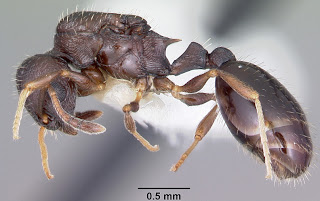Anti-Slavery Rebellion Present In Ants
It is common knowledge that worker ants are used for a simple yet enormous task: to exterminate the offspring of their parasites. It is a thankless job and it smacks of slavery in insect world but nevertheless necessary to ensure survival of the ant specie.
Ants held in captivity by other ant species are blunted of their aggressiveness. In 2009, Dr. Susanne Foitzik, an Ant researcher at Germany's Johannes Gutenberg University Mainz (JGU) first took notice of "slave rebellion" in ant colonies. Since then, more findings have confirmed that this behavior is pretty widespread and proved that the phenomenon observed by Foitzik was not isolated cases. In Ohio, New York and West Virginia, researchers have found enslaved Temnothorax longispinosus workers actually neglect and kill the descendants of their Protomognathus americanus slave makers, instead of providing care.
With this discovery, it is estimated that only about 45 % of these offspring of parasite managed to survive. This internal sabotage is expected to lower the presence of the parasites in the immediate vicinity and thus greatly boost the odds of survival for the surrounding colonies, presumably makeup of the relatives of the slave ants.
Image [Click to enlarge]
Probably over 50% of all animals are affected by parasites, organism that feed off the hosts. One particular parasite, the American slave-making ant Protomognathus americanus, has evolved through the history. It is a perfect example of parasite whose sole survival hinges on other ant species. Once worker ants are enslaved, they care for the young parasite offspring, bring food to the colony, and sometimes function as a first line of defense for the nest.
It all started when the host Temnothorax longispinosus came under attack by this slave-making ant colony. Older ants are killed, and the brood are captured and brought back to the masters' nest. This is where the exploitation starts. The oppressor would channel the inclination of the captive brood to serve to their advantage; they feed and care for the larvae, effectively assume the role to raise the parasite colony -- but with caveat.
Foitzik's theory is that the slaves were not able to tell that they are still in the enemy's colony. It is especially difficult to tell when they are only in contact with larvae. But as the larvae pupate, it is believed that the cuticles would emit certain chemicals that slave ants can apparently pick up. It is no surprise that a much higher proportion of the slavemaker are killed by slave ants during pupation stage. Either the caring stops abruptly or the pupae are torn into pieces. Without the protection of a cocoon and being immobile at this phase, these offspring are at complete mercy of slaves.
Image [Click to enlarge]
However it is difficult to generalize the casualty rate. According to the study, pupae in West Virginia has a pathetic survival rate of 27 %, and New York colonies can claim a higher rate of 49 %, with the chance of survival greatest in Ohio, an impressive 58 %. But keep in mind that as much as 85% of these pupae can survive in their own natural habitat (i.e. without worker ants from other colonies). But this killing has no direct bearing on the enslaved workers as they do not reproduce. However, an indirect benefit is that their neighboring relatives have a better chance to survive when young offspring from slavemakers are killed en masse. The havoc created by slave rebellions on slavemaker colonies would limit the encroachment of slavemaker specie into the neighborhood.
One explanation behind the vast differences of death tolls above from different regions could be the geographic mosaic theory of co-evolution. It stipulates that as specie settle on new environment, they mutate to fit the new surroundings, which directly influence their affinity to attack or defend, so evolution is a logical explanation on death rates in different geographic areas. All in all, it can be summarized this way: New York slavemakers are aggressive and able to negate huge onslaught by slave ants, and the hosts in West Virginia are more vulnerable due largely to its genetic similarity to the rebelling slaves.
The study to examine how slave rebellion has evolved is financed by the German Research Foundation. Named "The evolution of resistance and virulence in structured populations", it has been commissioned since October 2011.





Comments
Post a Comment